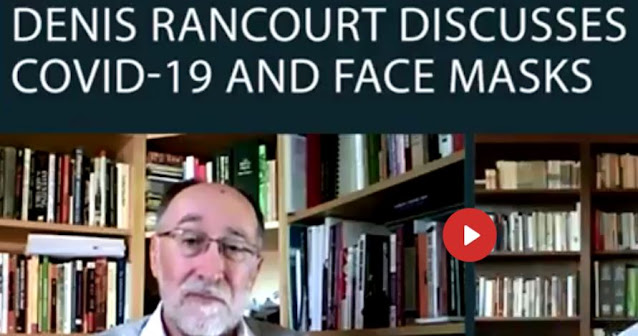Phd, former full Physics Professor
So, the government response to that World Health Organization recommendation is what killed people, what accelerated the deaths. You can see that in the data, and you can also understand it in terms of how immune-vulnerable people are affected by these kinds of diseases.
What they did is they closed people into their institutional places of residence, they didn't allow visitors. So, they isolated the most vulnerable parts of society that already had comorbidity conditions who were in a fragile state.
So, they ensured that many people that were locked into these institutions would die from this particular seasonal virus that causes the respiratory disease.
Click HERE to view Video
Dr. Joseph Mercola (Mercola Take Control of Your Health) interviews Denis Rancourt on the use of masks to control the spread of a virus. Use the link under the video to listen to the entire 1½ hour interview.
“What I found when I looked at all the randomized controlled trials with verified outcome, meaning you actually measure whether or not the person was infected … NONE of these well-designed studies that are intended to remove observational bias … found there was a statistically significant advantage of wearing a mask versus not wearing a mask.
Likewise, there was no detectable difference between respirators and surgical masks. That to me was a clear sign that the science was telling us they could not detect a positive utility of masks in this application.
We're talking many really [high-]quality trials. What this means — and this is very important — is that if there was any significant advantage to wearing a mask to reduce this [infection] risk, then you would have detected that in at least one of these trials, [yet] there's no sign of it."
The Importance of All-Cause Mortality Statistics
When trying to tease out whether an intervention works against COVID-19 or not, it’s important to look at death statistics. The number of deaths is really what’s important, not the number of infected individuals, as many may not even exhibit symptoms.
The problem is that assigning the cause of death in a situation where a viral infection taxes the immune system and is confounded by comorbidities is tricky business. As noted by Rancourt, epidemiologists have long known that you cannot reliably assign cause of death during a viral pandemic such as this. There’s tremendous bias involved.
To get around those problems, you have to look at all-cause mortality. The reason for this is because all-cause mortality data are not affected by reporting bias.
So, Rancourt did a detailed study of the current data of all-cause mortality, showing that the all-cause mortality this past winter was no different, statistically, from previous decades. In other words, COVID-19 is not a killer disease, and this pandemic has not brought anything out of the ordinary in terms of death toll.
Government Lockdown Orders
Fueled Death Toll
So, the government response to that World Health Organization recommendation is what killed people, what accelerated the deaths. You can see that in the data, and you can also understand it in terms of how immune-vulnerable people are affected by these kinds of diseases.
What they did is they closed people into their institutional places of residence, they didn't allow visitors. So, they isolated the most vulnerable parts of society that already had comorbidity conditions who were in a fragile state.
So, they ensured that many people that were locked into these institutions would die from this particular seasonal virus that causes the respiratory disease.


Comments
Post a Comment
Pending moderation, your comment will be published. Thank You